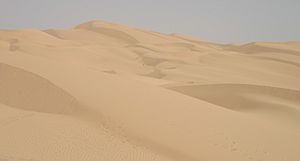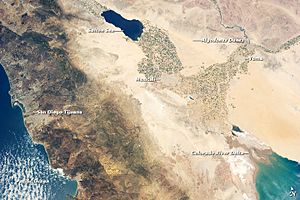Yuma Desert facts for kids
The Yuma Desert is a dry, sandy part of the larger Sonoran Desert. You can find it in the southwestern United States and the northwest of Mexico. It sits in a low area called the Salton basin. This desert has very few plants and is famous for its huge sand dunes.
With less than 8 inches (200 mm) of rain each year, it is one of the toughest deserts in North America. Not many people live here. The biggest city is Yuma, Arizona, which is right on the Colorado River and near the border of California.
Contents
Where is the Yuma Desert Located?
The Yuma Desert covers the lower parts of southwestern Arizona. It stretches west all the way to the Colorado River. On the other side of the river, in California, is another part of the Sonoran Desert called the Colorado Desert. People sometimes call it the Low Desert.
Even though only the Colorado River separates these two areas, many plants and animals live on only one side. For example, the saguaro cactus grows only east of the river.
The Yuma Desert also includes the sandy plains of western Sonora, Mexico. It reaches down to the top of the Gulf of California. Then it goes inland into the middle of the Sonoran Desert. The most important river in this desert is the Gila River in Arizona.
Several special natural places are found here. These include Organ Pipe Cactus National Monument, the Kofa National Wildlife Refuge, and the Cabeza Prieta National Wildlife Refuge.
South of Arizona's Yuma Desert, in northern Mexico, is the Pinacate volcanic area. This area is part of the Gran Desierto de Altar, which is the southern part of the Yuma Desert. It is located at the bottom of Mexico's western mountain range, the Sierra Madre Occidental.
Plants of the Yuma Desert
The most common plant here is the creosote bush (Larrea tridentata). It grows almost everywhere. The tall saguaro cactus (Carnegiea gigantea) and the ocotillo (Fouquieria splendens) are often seen on the gentle slopes called bajadas.
Many desert trees grow only near dry riverbeds. These include paloverde (Parkinsonia), the desert willow (Chilopsis linearis), desert ironwood (Olneya tesota), and smoke trees (Psorothamnus spinosus).
The Yuma Desert is also the northernmost place where you can find the Elephant Tree (Bursera microphylla) and the Blue Baja Lily (Triteleiopsis palmeri).
Animals of the Yuma Desert
You can learn more about the animals that live in this area by looking at the list in Category: Fauna of the Sonoran Desert.
See also
 In Spanish: Desierto de Yuma para niños
In Spanish: Desierto de Yuma para niños
- Chihuahuan Desert
- Lechuguilla Desert
- Tule Desert (Arizona)




